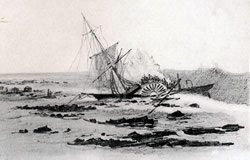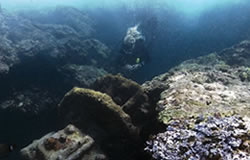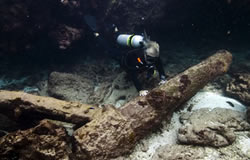American side wheel steamer USS Saginaw
Launched in 1859, USS Saginaw was the first naval vessel built on the West Coast. The small, wooden side-wheeler was powered by sails and steam engines. Saginaw's last deployment was to Midway Atoll in 1870, where a coal depot in support of transpacific commerce was to be built. For six months, she served as a support vessel for divers as they labored to clear a channel into the lagoon.
In October 1870, the unsuccessful operation was terminated. Saginaw set course for nearby Kure Atoll to check for castaways before returning to San Francisco. Captain Sicard navigated his ship cautiously through heavy swells under reduced sail. The moon had set, but they did not expect to be within range until daybreak. At 3:15 AM, waves were observed breaking ahead of the ship. The captain ordered the sails taken in and engines reversed but within minutes the reef crest punched through the hull and waves washed over the ship.
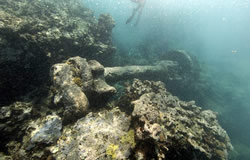
Maritime archaeologists float above one of two large paddle wheel shafts and hub beneath the surf zone at Kure Atoll. Credit: NOAA/Schwemmer
Rescuing provisions from the holds was the immediate priority. At daylight, the ship's boats were lowered, and the crew of 93 men made their way across the reef to Green Island as the Saginaw broke apart and sank beneath the waves. One last match was used to start a fire. Short rations were a concern, but even more critical was the limited amount of fresh water.
In such a remote location, the captain and crew could not count on a passing ship to save them. The captain's 22' gig was fashioned into a sailboat. The five volunteers who set off in it for the 1,200 mile rescue journey were barely alive when they reached the north shore of Kauai. Weakened by their 31-day ordeal, they were unable to control the boat as it capsized in the surf. William Halford, the lone survivor, was found by local residents who helped him on his way to Honolulu.
Within hours of Halford's arrival, the schooner Kona was dispatched for Kure. At the insistence of His Royal Highness Kamehameha V, the royal steamer Kilauea also set out on the rescue voyage. Both vessels reached the survivors – sixty-eight days after the shipwreck – on January 3, 1871.
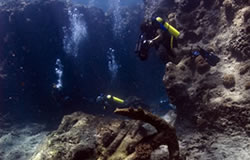
Stephani Gordon collects film footage of anchors at the USS Saginaw shipwreck site. Credit: NOAA/Casserley.
In 2003, a team of maritime archaeologists discovered features of the wrecksite inside the lagoon at Kure Atoll. A few days later, during a diver survey in the fore reef near the area where the artifacts were found inside of the lagoon, divers came across a portion of the wreck site that included two cannon, two anchors, a gudgeon and several small artifacts such as sheathing tacks and fasteners. Time was limited at the site, and weather would not permit another survey until 2006. A team of maritime archaeologists returned to the site and discovered dozens of new artifacts in the spur and groove topography of the fore reef including bow and stern Parrott rifled pivot guns, 24-pdr broadside howitzers, steam oscillating engine, port and starboard paddlewheel shafts, rim of paddlewheel, anchors, brass steam machinery, boiler tubes, rigging components, fasteners, rudder hardware, davits and a ship's bell in addition to the artifacts discovered in 2003. The discovery of the ship's bell was especially exciting.
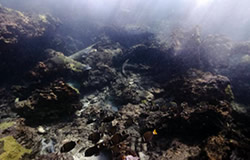
Paddle wheel shafts, anchors and artifacts in the reef at the Saginaw shipwreck site at Kure Atoll. Credit: NOAA/Casserley.
In 2008, a team returned to the site to continue survey. Because this site is in an extremely dynamic zone, no site plan has been possible to date. Entering data into a GIS project has been the primary means of data management. In 2008, plans to develop a maritime heritage themed exhibit at the Monument's Mokupāpapa Discovery Center in Hilo, Hawaii inspired NOAA maritime archaeologists to acquire the appropriate permits to recover the USS Saginaw's ship's bell for conservation and display. The 2008 team documented additional artifacts, and collected additional still photographs and the first high definition video footage of the site. The ship's bell and deep sea sounding lead have undergone thorough conservation and analysis and now reside at the Mokupāpapa Discovery Center in Hilo.
